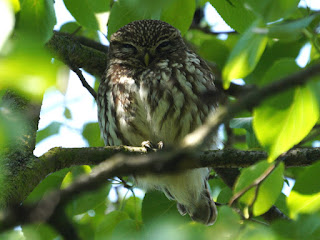Here is another video of them being fed -- I know we had one yesterday, but they are irresistible. Note that the adult is making an effort to feed them in rotation, so that the biggest and pushiest of the chicks doesn't always get the caterpillars.
One of the adults paused in a catalpa tree on the way to find more insects for them.
A Treecreeper near the leaf yard made itself noticed with its very quiet high-pitched call, and could be seen climbing an oak.
The Little Owl near the Henry Moore sculpture was in the alder tree again, in an obscure place which took ten minutes to find.
The young Grey Heron from the nest on the island was on the shore for the first time today. It was looking puzzled by the wide world.
Most of the Lesser Black-Backed Gulls here are mid grey rather than black. They are of the British and western European subspecies Larus fuscus graelsii. There are two other subpecies, the very dark L. fuscus fuscus, found in Scandinavia and the north -- it's the nominate form because Linnaeus was Swedish -- and L. f. intermedius, nearly as dark and seen mostly on the European mainland. This gull at Peter Pan is probably an intermedius.
This subadult Lesser Black-Back was in the pigeon-eater's territory and may be one of his offspring from a couple of years ago.
A Great Crested Grebe preened his immaculate white underside.
I think this Moorhen is just playing with two sticks, and doesn't intend to take them away to a nest. Moorhens climb trees for fun, but I've never seen one playing with objects before.
The Black Swan is still on the Serpentine. Someone had given it a Cheesy Wotsit.
The dominant Mute Swans on the Long Water seem to be serious about their new nest in the reed bed on the west side.
They still haven't done anything about the other nest on the gravel bank. They have been presented with a fait accompli and may feel that it's too much trouble to tackle now. A nesting bird would be extremely defensive and any fight would be a bloody one.
On the nest at the east end of the Lido, the male guarded the eggs while the female went off to feed and preen.
Joan Chatterley reports that the swans in St James's Park are well ahead of ours, and a pair have two cygnets.
The six Egyptian goslings on the Serpentine are obedient as Egyptian goslings go, and stay close to their mother. It has helped them to survive in hostile conditions for over three weeks, during which they have grown quite a lot.
This Mallard is often seen resting in an unused Grey Heron nest on the island. I don't think she's nesting. The secluded place keeps her away from the unwanted attentions of drakes.














There can never be enough pictures and videos of Long Tailed Tit babies.
ReplyDeletePerhaps the Moorhen wants to climb over that stick and doesn't know how to make it stand?
The young Heron appears to have the makings of a budding philosopher.
If to know that you know nothing is the beginning of wisdom, that will be a wise heron. The prospect is rather terrifying.
DeleteBrawns and brains. Brrrr.
DeleteNot much brawn -- a Grey Heron is as light as a Mallard -- but a terrible beak and the ability to aim it.
DeleteGood to see the Little Owl back again. Wonderful photo of those Long-tailed Tit chicks taken by Virginia- such an unusual shot!
ReplyDeleteVirginia must have had to wait ages to get all five chicks looking out, and her patience was well rewarded.
Delete